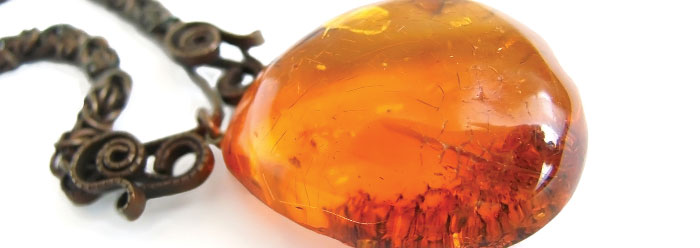Amber has been prized for centuries for its beauty. Some specimens have dazzling colors, like a cache recently discovered at Cape York in far northern Australia. Insects, diatoms, a lizard leg, fruits, and even mammal hairs have been found trapped inside these gems. Amber is often represented as being millions of years old, but clear evidence points to its recent and rapid origin.
Nodules that are chemically the same as "ancient" ambers form today from tree resin. Resin is different from sap, which transports nutrients. When certain trees are wounded, resin is extruded as a viscous liquid and hardens according to well-known chemical reactions that do not take millions of years. Resins are part of trees' immune systems and, in addition to their ability to quickly "coagulate," their constituent chemicals are known to combat fungi and bacteria.
In the study of the Australian amber, investigator Suzanne Hand of the University of New South Wales said that, like many ambers used as jewelry, the "pieces we've looked at have inclusions of beautifully preserved plant and animal remains that were trapped in the resin before it hardened."1
If it took very long for the resin to harden, then the trapped insects would probably not have been preserved, since over time they would have worked themselves free, been scavenged, or decayed. Indeed, the speed with which resin hardens is what makes it useful as a furniture varnish. It solidifies on trees continually and rapidly. In the form of sandarac or myrrh, for example, hardened pieces are used as incense in Arabia and as medicine by Africans. The same chemicals that comprise the majority of fossil amber, called "resinite," can produce amber in laboratories as well.2
Therefore, if ambers are millions of years old, then they must have been sitting around on earth for all that time after their rapid initial hardening. But if that is the case, according to chemical laws the organic remains trapped inside should have spontaneously decayed by now. So why did a recent press release state that Australian ambers were "from millions of years ago"?1 The report referred to the "beautifully preserved" insects caught in the amber. If these are the remains of insects trapped millions of years ago, why have they not yet become the dilapidated residue that would be expected?3
Amazingly, scores of still-living bacteria have been extracted and identified from insect guts trapped in California ambers.4 These invisible creatures could only have accelerated the decay of the insects.
Just as incredible to those who insist on amber's great age, still-living yeast cells were extracted from amber. A small brewery in Guerneville, California, brewed with them, convinced the cells were somehow preserved for "45 million years."5 But trapped in amber, their metabolic waste should have fatally poisoned them eons ago.
The quality preservation of whole insect bodies shows that amber hardened rapidly and recently. The chemistry of amber formation is known to occur quickly. Microbes trapped in amber could only still be alive if they were trapped recently. Amber is no friend to deep time. That's why amber jewelry could be a great way to start a conversation about the trustworthiness of a plain reading of Genesis.
References
- Beale, B. Australian amber is treasure trove of ancient life. University of New South Wales press release, June 17, 2010.
- Man-made "amber" is called "synthetic polycommunic acid." See Hatcher, P. G. and D. J. Clifford. 1997. The organic geochemistry of coal: from plant materials to coal. Organic Geochemistry. 27 (5-6): 262.
- Insect exoskeletons are made of chitin, and "because of the lability of chitin, chitinous structures are normally considered to have a relatively low preservation potential." Sephton, M. A. et al. 2009. Chemical constitution of a Permian-Triassic disaster species. Geology. 37 (10): 875.
- For example, see Cano, R. J and M. K. Borucki. 1995. Revival and identification of bacterial spores in 25- to 40-million-year-old Dominican amber. Science. 268 (5213): 1060-1064.
- Thomas, B. '45 Million Year Old' Brewer's Yeast Still Works. ICR News. Posted on icr.org August 17, 2009, accessed June 21, 2010.
* Mr. Thomas is Science Writer at the Institute for Creation Research.
Cite this article: Thomas, B. 2010. Amber Jewelry: A Conversation Piece for Creation Evidence. Acts & Facts. 39 (9): 17.








